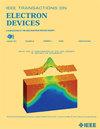基于f等离子体处理的双极性SnO薄膜晶体管的高增益类cmos逆变器
IF 3.2
2区 工程技术
Q2 ENGINEERING, ELECTRICAL & ELECTRONIC
引用次数: 0
摘要
尽管基于双极薄膜晶体管(TFTs)的类cmos逆变器由于其简化的制造和高集成密度而引起了人们的极大兴趣,但实现高性能的双极薄膜晶体管仍然具有挑战性。在这项工作中,我们系统地研究了不同的退火和钝化方案-包括无钝化退火(AWP),钝化前退火(ABP)和钝化后退火(AAP) -使用SiO2, Al2O3和HfO2钝化层(pvl)对SnO tft性能的影响。其中,AAP-Al2O3器件表现出最平衡的p型和n型导通,以及优异的负偏压(NBS)稳定性。此外,氟(F)等离子体处理显著增强了SnO通道的双极性特性,包括开/关电流比、亚阈值摆幅(SS)和偏置应力稳定性。最后,由两个相同的f等离子体处理的双极性SnO tft组成的类似cmos的逆变器在8 V的低电源电压下获得了289的异常高电压增益。这项工作为开发适用于下一代低成本电子产品的薄膜类cmos电路提供了一种简单有效的策略。本文章由计算机程序翻译,如有差异,请以英文原文为准。
High-Gain CMOS-Like Inverters Based on F-Plasma-Treated Ambipolar SnO Thin-Film Transistors
Although CMOS-like inverters based on ambipolar thin-film transistors (TFTs) have garnered significant interest due to their simplified fabrication and high integration density, achieving high-performance ambipolar TFTs remains challenging. In this work, we systematically investigate the effects of different annealing and passivation schemes—including annealing without passivation (AWP), annealing before passivation (ABP), and annealing after passivation (AAP)—using SiO2, Al2O3, and HfO2 passivation layers (PVLs) on the performance of SnO TFTs. Among them, the AAP-Al2O3 device exhibits the most balanced p-type and n-type conduction and superior negative bias stress (NBS) stability. Furthermore, the ambipolar characteristics, including the on/off current ratio, subthreshold swing (SS), and bias stress stability, were significantly enhanced by fluorine (F) plasma treatment on the SnO channel. Finally, a CMOS-like inverter composed of two identical F-plasma-treated ambipolar SnO TFTs achieved an exceptionally high voltage gain of 289 at a low supply voltage of 8 V. This work offers a simple and effective strategy for developing thin-film CMOS-like circuits suitable for the next-generation cost-effective electronics.
求助全文
通过发布文献求助,成功后即可免费获取论文全文。
去求助
来源期刊

IEEE Transactions on Electron Devices
工程技术-工程:电子与电气
CiteScore
5.80
自引率
16.10%
发文量
937
审稿时长
3.8 months
期刊介绍:
IEEE Transactions on Electron Devices publishes original and significant contributions relating to the theory, modeling, design, performance and reliability of electron and ion integrated circuit devices and interconnects, involving insulators, metals, organic materials, micro-plasmas, semiconductors, quantum-effect structures, vacuum devices, and emerging materials with applications in bioelectronics, biomedical electronics, computation, communications, displays, microelectromechanics, imaging, micro-actuators, nanoelectronics, optoelectronics, photovoltaics, power ICs and micro-sensors. Tutorial and review papers on these subjects are also published and occasional special issues appear to present a collection of papers which treat particular areas in more depth and breadth.
 求助内容:
求助内容: 应助结果提醒方式:
应助结果提醒方式:


